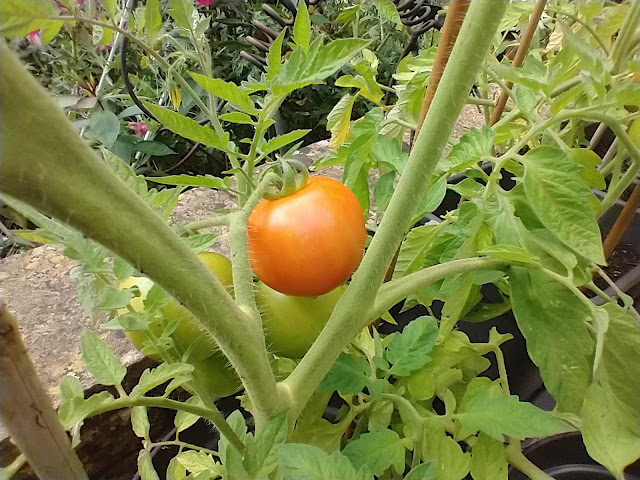Testing Times: Tomatoes
I've run a couple of tomato trials this year. The first is a revisit of the biochar trial with Oxford University I attempted some years ago (with a different organisation this time), and the second is a trial of a water gadget called Plantsurge which I was given to try at Malvern Spring Show earlier this year.
Most of you have probably heard of biochar already and the claim that this inert, carbon-rich material can help soil fertility and plant health. The RHS information in the above link says results can be mixed, with reduced effects found in alkaline soils. This may help to explain the lack of difference I found in my previous trial as VP Gardens is on a lime-rich soil.
Plantsurge is a different beast altogether. It's a strong magnet which is attached to a hosepipe as shown in the photo above. It's claimed that it softens water, with the result more like watering with rainwater. The higher nitrogen found in rainwater is thought to be beneficial to plants. Gardeners who've trialled the product already report improved growth, flowers and fruits with their plants. My initial thought was it sounded too much of a gimmick to be true, but if it could do the same for me, then I was keen to try.
I used nine plants for the trial, three for each treatment category. Why three plants? The biochar trial specified the use of three plants per category and I simply added an extra three for the magnetised water. My chosen plants were 'Crimson Crush' as I grow my tomatoes outdoors and a blight resistant tomato gives me the bast chance of producing a good crop. All plants were grown in equal quantities of Dalefoot tomato compost on my patio allotment and they had a constant supply of water through a wick and tray system I set up. I've found method this is an excellent way of preventing blossom end rot in the past.
I've had little success with mail order plants in recent years, so I was pleased to find Simpson's Seeds is local to me and has in-person sales as well as the mail order operation they run. Having enquired on availability, I was delighted to find nine healthy and even sized plants all boxed up and waiting for me when I picked them up in June. I planted them out straight away as we were enjoying such good weather then (ha!). Flowering and fruit set began within days of planting. So far, so good...
Then of course we had a miserable July, which has mostly continued into August too. My tomato plants just stared back at me forlornly, refusing to ripen their fruits and with little sign of anything developing beyond the second truss.
Then I received this report a couple of days ago - eek!
As you can see the results are mixed, with winners and losers in all categories, though on the whole the Control plants have the lowest results. I'm surprised the plants with both treatments had a lower yield than the single treatment as my hypothesis was both treatments would give a double gain for this part of my crop. With just three plants though it's hard to say if this difference is significant (the biochar treated plants cropped around 88% of the magnetised water only ones). The same remark also applies to comparison with the control, though it's gratifying to see both treatments have higher yields (plus 13% for the biochar/magnet and plus 27% for the magnet only). I'm one of many gardeners involved with the biochar trial, so it will be interesting to see what our pooled results are.














Comments
Post a Comment
I love hearing from you and welcome thoughtful conversations :)
Comments aiming to link back and give credence to commercial websites will be composted!